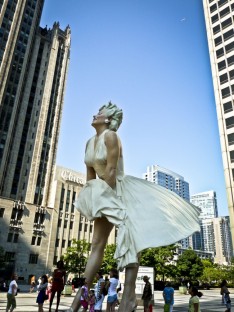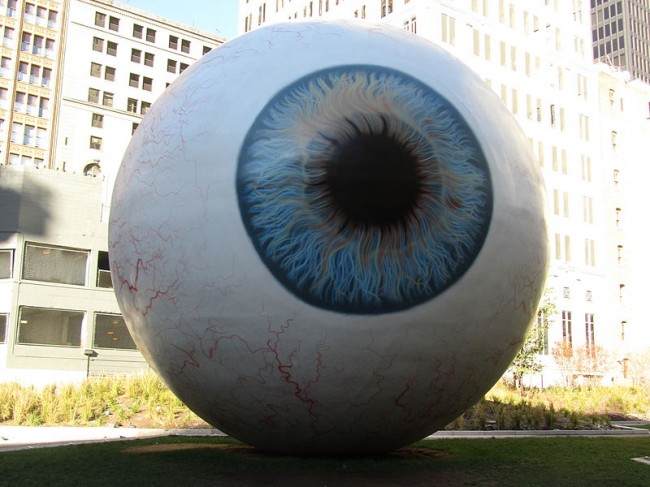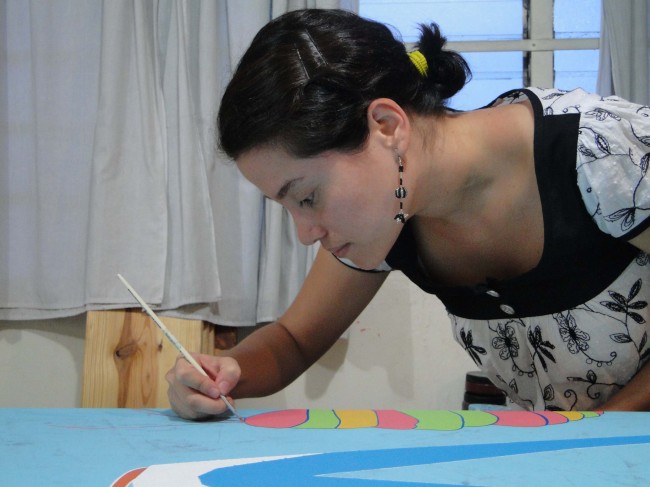
With red lips, long legs, and a flash of panties, Forever Marilyn, a new 26-foot stainless steel and aluminum sculpture by John Seward Johnson II, was unveiled on July 15 in Pioneer Plaza on Michigan Avenue. Trapped in the notorious sewer-grate-gust-of-air-meets-full-skirt pose from the classic 1955 movie “The Seven Year Itch,” Marilyn is monumentalized with downcast eyes and her hands buried in the white fabric of her dress, in a failed Birth of Venus gesture. And watch out, Cloud Gate – dwarfed beneath the giant, ill-fated starlet, pedestrians get a prime, objectifying view of her thighs, crotch and bum, making the bottom half of the sculpture the focus of a new competition for best tourist photo op.
Commissioned by Paul Zeller, President and CEO of Zeller Reality Group in collaboration with The Sculpture Foundation, the Marilyn Monroe sculpture strives to rekindle the attitude of an era in which “we, as a nation and a people, were proud, productive, optimistic and self-assured, if a bit mischievous,” said Zeller in a press release. But these naïve ideals are lost in the image of the curvy blonde, so depressed that she ended her own life at age 36.
Critics across the country are swiftly reacting to the piece with almost entirely negative commentary. As Eric Felten points out in his Wall Street Journal opinion piece on the sculpture, iconic images become empty clichés after repeated appropriation. It’s easy to see what he’s saying when looking at Johnson’s body of work. Johnson is also the artist to blame for the giant American Gothic-inspired caricatures that were plopped on the same site near the Chicago River in 2008. He’s created many other weird, crudely imagined drones including sculptures inspired by Matisse’s Dance of Life, and Van Gogh’s L’Arlésienne, always succeeding in sucking the emotion from iconic moments in cinema and art.
In addition to the fact that the subject has nothing to do with Chicago, Forever Marilyn is a disturbing, impossible-to-ignore celebration of the male gaze. Speaking for my female self, I went through an array of feelings about the piece: shock, disbelief, anger, resentment, and sadness. Now I’ve settled on embarrassment. As SAIC alum Abraham Ritchie remarks on his Chicago Art Blog, this “creepy, sexist” work “caters to cheap titillation” and frat-boy behavior; Ritchie’s sentiments resounded with opinions published around the world, including in Artinfo.com and The Guardian.
Vegas-like in form, Forever Marilyn is renounced by some as singularly kitsch, and not as art at all. But Johnson identifies himself as an artist that takes moments from the history of pop culture as his muses, engorging them into large-scale works for public consumption. So it’s fair game to discuss it with the seriousness of any other piece of art, and Chicagoans will have plenty of time to, since we’re all stuck with Marilyn until spring of 2012. It’s really too bad she’s not more out-of-sight, like in front of Bubba Gumps on Navy Pier.

Tony Tasset’s hugely controversial public sculpture, Eye, of last year, along with the eye-full Johnson has given us, create a growing reputation for public art in Chicago that diverges from its lineage of famous pieces like the Daley Center’s Picasso, and even Kapoor’s much loved, shiny, interactive Bean. Big, familiar, and gross seems to be the formula (although at least Tasset’s Eye wasn’t offensive, and was arguably more likeable). In Marilyn’s case, Johnson’s poor craftsmanship and most of all, taste, only propagate Chicago stereotypes of an unsophisticated art scene to New York and elsewhere, obscuring all the good stuff happening here.








[…] "Seven-Year Kitsch" – Forever Marilyn receives more negative criticism, "[The artist, J. Seward Johnson, is] always succeeding in sucking the emotion from iconic moments in cinema and art." (Mia DiMeo) […]